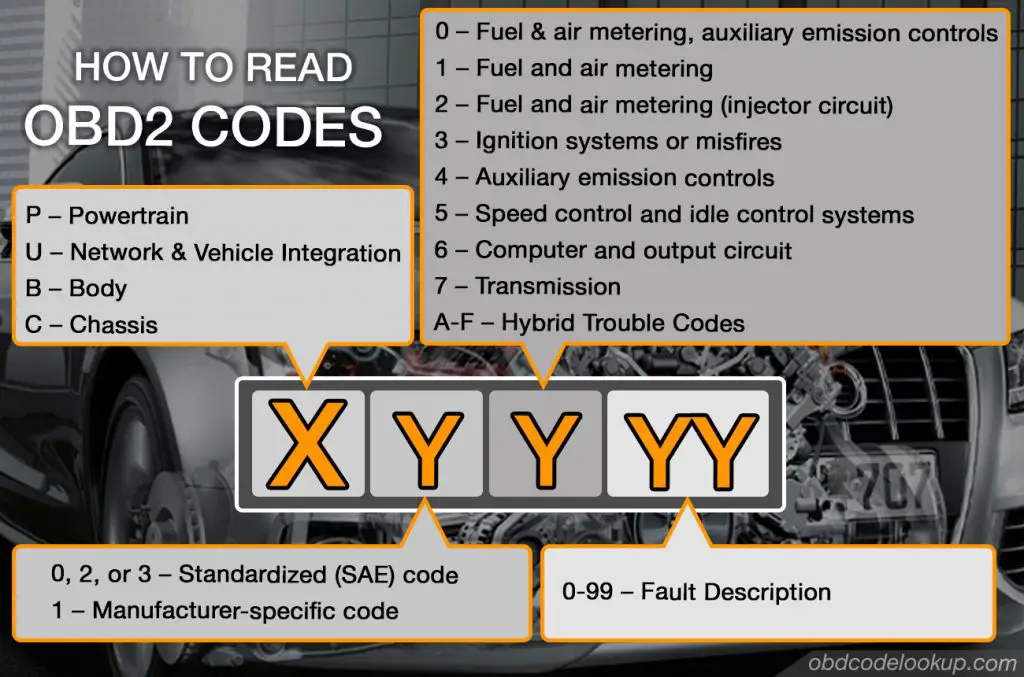Why OBDCodeLookup.com?
At OBD Code Lookup, you will find the symptoms, causes, and how to fix any OBD2 code on any vehicles.
Other details about each code you can have are:
- Tech Notes
- Cost To Diagnose
- When is the code detected
- Descriptions
How OBDCodeLookup works?
How to search for a code?
Case 1: If your code is manufacturer-specific (P1xxx, C1xxx, B1xxx, U1xxx), the search term should include the code and your car brand, (e.g. P1220 Audi). You can also search P1220 but then you have to choose the right results from the list found.
Case 2: If your code is generic (P0xxx, C0xxx, B0xxx, etc.), you don’t have to include the car make in the search term, (e.g. P0012). Why? These codes are generic and have the same meaning for any car brand.
What if I cannot find my code?
Let us know about the code and the problems you are having by using this form.
A member of OBDCodeLookup will contact and support you.
What is an OBD2 Code?
OBD (onboard diagnostics) is an electronic system that can self-diagnose and give reports about the status of systems in your vehicle.
Whenever an issue is detected, the system will store a relative OBD code, also known as a diagnostic trouble code (DTC). With an OBD scan tool you can read that code to find what happened to your car. For example, when you find the code P0134, your car is having problems with the O2 sensor such as:
- Front Heated Oxygen Sensor Bank 1 harness is open or shorted
- Front Heated Oxygen Sensor Bank 1 circuit poor electrical connection
- Faulty Front Heated Oxygen Sensor Bank 1
- Inappropriate fuel pressure
- Faulty fuel injectors
- Intake air leaks may be faulty
- Exhaust gas leaks
For short, OBD2 code (also called DTC) is an diagnostic trouble code triggered when a problem happens to an OBD2 vehicle. These are cars, SUVs, light trucks, etc. made/sold in the US since Jan 1996.
Types of OBD2 Codes?
There are 2 main types of OBD2 codes, generic and manufacturer-specific.
Generic codes are universal and mutually agreed by all auto manufacturers to make sure that a generic code means the same thing on all cars from all makers.
Manufacturer-specific codes are privately used by each auto manufacturer, which means that the code P1220 on an Audi is different from a BMW.
How to Read an OBD2 code

OBD provides monitoring for various systems. They include the engine control module, body, chassis, etc. When you look at an OBD2 code, you can immediately tell where the fault is by reading the letters and numbers it contains. Below is a breakdown.
The First Character (Letter)
All OBDII codes start with a letter that denotes the part of the vehicle that has a fault. Let’s check it out, shall we?
P – Powertrain. It includes the engine, transmission, and all the associated accessories.
U – Network & Vehicle Integration. These are functions that are managed and shared by onboard computer systems.
B – Body. These are parts mainly found in the passenger compartment area.
C – Chassis. It covers mechanical systems and functions like steering, suspension, and braking.
The Second Character (Number)
A number usually follows the first letter. This number can only be ‘0’, ‘1’, ‘2’, or ‘3’.
0, 2, or 3 – If it’s a ‘0’, ‘2’, or ‘3’, the code is a standardized (SAE) code; also known as generic code.
1 – If it’s a ‘1’, you’re looking at a manufacturer-specific code
The Third Character (Number/Letter)
This number denotes the particular vehicle system that has a fault. There are eight systems in total:
0 – Fuel and air metering and auxiliary emission controls
1 – Fuel and air metering
2 – Fuel and air metering (injector circuit)
3 – Ignition systems or misfires
4 – Auxiliary emission controls
5 – Vehicle speed control and idle control systems
6 – Computer and output circuit
7 – Transmission
A-F – Hybrid Trouble Codes
The Fourth And Fifth Characters (Number)
The final piece of a DTC is a two-digit number. This number defines the exact problem that you’re dealing with. It can be any number between 0 and 99.
As you can see, a typical DTC has five characters in total, and each one of those characters gives it a description.
For example, if you get the code P0219, it means that the car has an engine over-speed condition. The ‘P’ means that the problem is in the powertrain. The ‘0’ means that it’s a generic code, while the ‘2’ refers to the fuel and air metering (injector circuit) system. The last two digits (19) define the problem, i.e., an over-speed condition.